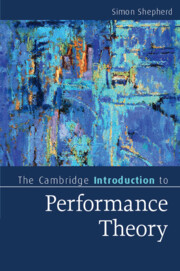Book contents
- Frontmatter
- Contents
- Preface
- Part I Definitions of performance
- Part II The emergence of performance as sensuous practice
- 6 Situationism, games and subversion
- 7 Hippies and expressive play
- 8 Performance as a new pedagogy
- 9 Architecture and the performed city
- 10 New forms of activism
- 11 Happenings and everyday performance
- 12 Body art and feminism
- 13 The arrival of Performance Art and Live Art
- 14 Dance party politics
- Part III Theorising performance
- Closing note
- References
- Index
- Cambridge Introductions to …
11 - Happenings and everyday performance
from Part II - The emergence of performance as sensuous practice
Published online by Cambridge University Press: 05 February 2016
- Frontmatter
- Contents
- Preface
- Part I Definitions of performance
- Part II The emergence of performance as sensuous practice
- 6 Situationism, games and subversion
- 7 Hippies and expressive play
- 8 Performance as a new pedagogy
- 9 Architecture and the performed city
- 10 New forms of activism
- 11 Happenings and everyday performance
- 12 Body art and feminism
- 13 The arrival of Performance Art and Live Art
- 14 Dance party politics
- Part III Theorising performance
- Closing note
- References
- Index
- Cambridge Introductions to …
Summary
At 1 pm on Sunday, May 16, 1965, something over a hundred people in dark clothes stood in silence at the entrance to Los Angeles's new County Art Museum. The people were artists and they were making a protest.
The Tower on Cieniga Boulevard
The event was one of a series over a weekend in the gallery quarter of Los Angeles. It led from here to a larger scale event that opened in late February 1966. This was a structure built at the junction of Sunset Boulevard and La Cieniga Boulevard in West Hollywood, the ‘Artists Tower of Protest against the War in Vietnam’. The Tower consisted of a range of artworks contributed by numerous artists. Their aim was to create an outdoor event that lasted over time, so that it could not be ignored by the press, and was collectively composed, so that it would resist becoming another collectable art commodity.
The positioning of the Tower was very precise. La Cieniga Boulevard was full of art galleries and the crowds they drew constituted an image of the city's civil prowess and importance, seen on display in ‘the weekly Monday night ritual of “La Cieniga art walk”’. Although some of the galleries had a close relationship with avant-garde art and oppositional politics, in general in southern California ‘high culture was an important activity, process and pleasure for its participants and collectors, many of whom were in the military and science-based corporations and institutes’ (Frascina 1999: 61, 26). High art and gallery culture were thus readily associated with a dominant, oppressive, order. The floodlit Tower on the hill above showed that it was not content with the Boulevard's spectacle.
Artists who were opposed to the oppressive order of those who had the money faced the problem of how to take cheap action which would cause maximum disruption. So they developed strategies ‘to think of the ideas of the “space”, the “theatre”, the disposable and transitory life of the streets’. What they came up with was, among other things, the silent vigil in dark clothes at the entrance to a new gallery and the great collective Tower of Protest. Looking back three or so decades later, one of the organisers of that Tower, Irving Petlin, described it ‘as an “event”, a version of “situationist” street politics’.
Information
- Type
- Chapter
- Information
- The Cambridge Introduction to Performance Theory , pp. 102 - 116Publisher: Cambridge University PressPrint publication year: 2016
